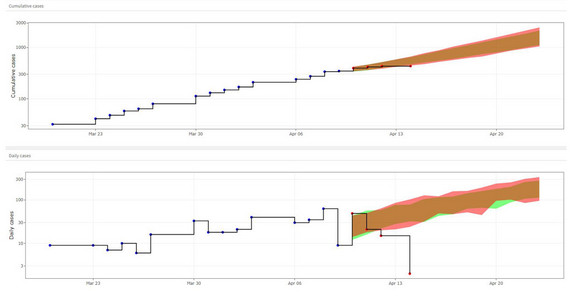The current COVID-19 pandemic is characterized – in Germany just like in all affected countries – by a rapid increase in the number of cases and strong regional differences. In addition to observing national and state trends, it is therefore useful to create mathematical models for the progression of the virus in smaller regions. Due to comparatively low case numbers, however, this is usually almost impossible. The model from Potsdam can close this gap, as explained by the physicist Ralf Engbert, Professor of Experimental and Biological Psychology: “We use a standard epidemiological model, but in a lesser-known stochastic version that is suitable for the description of regional dynamics with comparatively small case numbers. By using an Ensemble Kalman filter, we show that the model has good prognostic properties at the rural district level.”
In the so-called SEIR model, the population is divided into four groups (SEIR), with the most important observation parameter being infected individuals (I). All those who can be infected – in the case of COVID-19, the entire population – form the group of susceptibles (S). Once a person has recovered from the disease (R) they are immune. An undetectable group consists of those individuals who have been exposed (E) but are still in the latency period, so that they do not show any symptoms. This group makes it so difficult to predict and contain the epidemic, because with COVID-19, infected individuals become infectious and may infect others before symptoms even appear.
The stochastic model of the Potsdam researchers reflects the dynamics of all four groups. A key model parameter is the contact rate, which determines how likely it is that a susceptible individual will be infected when exposed to an infectious person. With the help of a so-called "Ensemble Kalman filter" – a mathematical filter suitable for problems with a large number of variables – the model can be dynamically adapted to the time series of the observed case numbers. As it turned out, the model can therefore also be used for relatively small data sets – for example, individual rural or urban districts.
For the publication of their model, the researchers generated two predictions. The first was developed taking into account the current contact ban situation and shows a slow decline in new infections for most rural districts. For the second prediction, the scientists assumed that the initial situation prior to the contact ban had been restored and all restrictive measures had been lifted. As a result, a dramatic increase in new infections was observed for all rural districts.
In addition to cognitive scientist Engbert and his doctoral student Maximilian Rabe, the interdisciplinary research team also includes psychologist Prof. Dr. Reinhold Kliegl and the mathematician and spokesperson of the collaborative research center “Data Assimilation”, Prof. Dr. Sebastian Reich, who emphasizes the importance of the collaborative research center: We believe that we can raise awareness for the benefits of large-scale projects and interdisciplinary research foci through our work. Of course, we hope to contribute, as have many other colleagues at our university, to the scientific and societal debate on how best to overcome the COVD-19 challenges.”
Additional information:
Preprint of the manuscript: https://doi.org/10.1101/2020.04.13.20063768
Dynamic model: https://engbertlab.shinyapps.io/covid19-dashboard/
Website of the collaborative research center “Data Assimilation”: https://www.sfb1294.de/news
Contact:
Prof. Dr. Ralf Engbert, Professor of Experimental and Biological Psychology, E-Mail: ralf.engbertuuni-potsdampde, Phone: 0331/977-2140
Prof. Dr.-Ing. Sebastian Reich, Professor for Numerical Mathematics, E-Mail: sebastian.reichuuni-potsdampde, 0331/977-1859
Media information 20-04-2020 / No. 047

